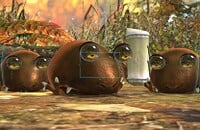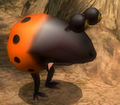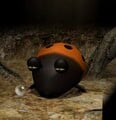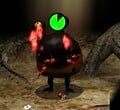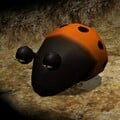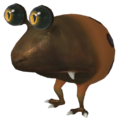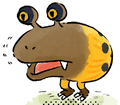Orange Bulborb
The Orange Bulborb (テンテンチャッピー?, lit.: "Restless Chappy") is an enemy that first debuted in Pikmin 2, making further appearances in Pikmin 3 and Pikmin 4. Compared to normal Bulborbs, Orange Bulborbs have brown skin, bloodshot yellow eyes, and an orange backside with brown spots.
Orange Bulborbs are extremely light sleepers. As such, they will detect Pikmin and leaders and attack much sooner than other grub-dogs. Their detection range is approximately the same as the cursor's range in the both the Gamecube games and the Switch ports, assuming motion controls are off. As such, it is nearly impossible to ambush an Orange Bulborb, even when attacking directly from behind. They also have slightly more health compared to their Bulborb brethren; all of these factors combine to make them dangerous opponents.
While rather common enemies in Pikmin 2, they are much rarer in the following games, often only appearing a few times throughout the campaign. They tend to be slightly more common in Mission Mode, Dandori Battles, and Dandori Challenges, however.
Stats[edit]
| Game | Weight | Max. carriers |
Seeds | Value | Health | Regen. |
|---|---|---|---|---|---|---|
| 10 | 20 | 12 | 850 | 2.55 HP/s | ||
| 10 | 20 (normally) | 15 | 1800 | No | ||
| 10 | 20 | 12 | 1800 | No |
Behavior[edit]
Orange Bulborbs are, like the Bulborb, nocturnal creatures and sleep in mainly underground areas, but can still be found above ground. In the main series of games, this exposes them to being swarmed by Pikmin. However, due to their high-strung nature, they will wake up more often as they can sense both Pikmin and Leaders if too close. They will also chase the Pikmin or Leader for a longer distance compared to a regular Bulborb.
Once awoken, the Orange Bulborb behaves identically to any other adult Bulborb species, rushing towards any nearby Pikmin or leader to try and eat them. If it manages to reach any Pikmin, it will stand up to eat them; otherwise it will attempt to attack again after tripping. If there are multiple Pikmin attacking the creature all at once, it will shake itself to throw Pikmin off of itself and try to eat more Pikmin.
If there is nothing to attack or eat, it will look around, return to its territory, and fall back asleep. In Pikmin 4, they will often fall asleep on the spot after losing their target, instead of returning to their starting location.
Exclusively in Pikmin 3, their eyes are a weak point: throwing a Pikmin at them will cause the Orange Bulborb to panic, forcing it to stop whatever it was doing (even if it was in the middle of eating Pikmin) to shake off all of its attackers.
Locations[edit]
Strategy[edit]
If a large group of Purple Pikmin is available, simply rain them down on the Orange Bulborb. Even with the Bulborb's head start, the purples will have a good chance of stunning it with serious damage, and hopefully defeating it without losses. This process will be noticeably simpler if you're playing on the Wii port or the Switch port: In these versions, the cursor's range is much greater than the GameCube versions, allowing you to pummel it with virtually zero risk. You will have to enable motion controls on the Switch port to get this effect, however.
If purples are not available, the battle will be significantly trickier. It's never wise to attack a large grub-dog from the front since they'll almost surely bite back, and since the Orange Bulborb will wake up before it can be attacked clearly, this will likely result in massive Pikmin losses. If it is approached from the back, quickly run at it and rain Pikmin on it. It can then be defeated like any other Bulborb. If there is no choice but to approach it from the front, dismiss the Pikmin and use a leader to wake it up. Let the Bulborb chase them until it runs out of its range. When it goes back to sleep, attack it in the back. Orange Bulborbs also have a slight delay in between its "yawning" sequence and waking up again, so use this opportunity to pummel it with Pikmin.
In Pikmin 3, the Orange Bulborb retains all of its traits from Pikmin 2. They are generally slightly harder to defeat, mostly due to the lack of Purple Pikmin in 3's story mode. However, there are other strategies players can use now to take it down. As with all grub-dogs in 3, their eyes are weak points; tossing a Pikmin at them will cause the Bulborb to panic, interrupting anything it was doing (including eating Pikmin), making a frontal assault potentially viable with decent accuracy. Additionally, as all Pikmin can hold bomb rocks, you can simply use them to quickly defeat the Bulborb if in a hurry, or if your squad is on the smaller side.
The only Orange Bulborb that you are explicitly required to defeat to obtain all fruits is the one in the Tropical Wilds; the group of 3 near the Portable Sunset in the Twilight River can be left alone by lifting the nearby bamboo gate. The one in the Tropical Wilds is facing away from the gate, so Bomb Rocks are recommended. Alternatively, the Bulborb can be awoken, and if the player runs away fast enough, it will go back to sleep facing the wall, allowing for an easier attack.
Biology[edit]
Orange Bulborbs are quite similar in design to the regular Bulborb, which is a creature with one of the most diverse physiology in the Pikmin series. They possess traits similar to those of amphibians, reptiles, and mammals. Orange Bulborbs have large bulbous eyes set in stalks, as opposed to the compound eyes of most insects. The eyes of the creature are described by Olimar as being yellow in color as well as being bloodshot, giving it it’s more high-strung nature
Olimar mentions Bulborbs having a set of mandibles, which can also be seen in the Orange Bulborb. Mandibles are a pair of appendages near an insect's mouth, used for grinding and chewing food. The so-called mandibles Olimar mentions in his notes look nothing like normal mandibles and are instead most likely saber-teeth, used for breaking exoskeletons of prey insects and digging through the soil for roots.
No true Dwarf Orange Bulborbs are known to exist. While Orange Bulborbs very commonly sleep near breadbug mimics that look similar to them, this could simply be the Orange Bulborb mistaking the breadbug mimic as its own young. Given Olimar's notes on the Albino Dwarf Bulborb suggest that it is "impossible to tell which subspecies" a particular Albino Dwarf Bulborb might mature into until the second molt, it is likely that true Dwarf Orange Bulborbs do exist, but simply have not been seen.
Notes
Olimar's notes
Louie's notes
Alph's comments
“Structural flaw: eyeballs, back
Weight: 10
“Structural flaw: eyeballs, back
Weight: 10
Brittany's comments
Charlie's comments
Louie's comments
Olimar's comments
“Orange Bulborb
Oculus kageyamii orangium
Grub-dog family
“Orange Bulborb
Oculus kageyamii orangium
Grub-dog family
Pikmin 2 Nintendo Player's Guide[edit]
Pikmin 3 Prima Guide[edit]
Dalmo's notes[edit]
Olimar's notes (Pikmin 4)[edit]
Louie's notes (Pikmin 4)[edit]
Technical information[edit]
| showPikmin 2 technical information (?) |
|---|
| showPikmin 3 technical information (?) |
|---|
Other information[edit]
- Size: Body length: 90mm, as per the e-card
- Pikmin 2 Piklopedia number: #3
- Pikmin 4 Piklopedia number: #6
- This enemy triggers the Auto Target Lock note in the Rescue Journal
Naming[edit]
- See more: Grub-dog family#Naming.
- Common name: Orange Bulborbs. They are distinguished from the remaining Bulborbs by being orange, hence their name.
- Japanese nickname: テンテンチャッピー?. テンテン? has the dual meaning of 輾転? (lit.: "tossing and turning (in bed)") and 点々? (lit.: "many dots"). チャッピー? (lit.: "Chappy") is Japanese for "Bulborb".
- Japanese name: ダイダイデメマダラ?, lit.: "Spotted Orange Bug-eye".
- Scientific name: Oculus kageyamii orangium. Oculus kageyamii is the species name for the Bulborbs, and orangium is similar to the English word "orange".
- Internal names: Internally, they are called
bluechappyin Pikmin 2 due to the fact that yellow and blue Bulborbs were planned to exist during development, but over time the blue Bulborb got changed into the Orange Bulborb. In Pikmin 3, this enemy is internally recognized as being the same as the Bulborb, so its internal name ischappy, but when it needs to be distinguished, it is calledtenten, over its Japanese name. In Pikmin 4, it is changed toTENTENCHAPPY, which matches its Japanese common name. - Prerelease: None.
Names in other languages[edit]
| Language | Name | Meaning | Notes |
|---|---|---|---|
| テンテンチャッピー? Tenten Chappī |
Restless Chappy | "Chappy" is the Japanese name for Bulborb | |
(traditional) |
點點恰比 Diǎndiǎn Qiàbǐ |
Tiny-Speckled Chappy | "Qiàbǐ" is the Chinese (traditional) name for Bulborb |
(simplified) |
点点恰比 Diǎndiǎn Qiàbǐ |
Tiny-Speckled Chappy | "Qiàbǐ" is the Chinese (simplified) name for Bulborb |
| Oranje bulborb | Orange bulborb | ||
| Bulborbe Orange Bulborbe orange (Pikmin 4) |
Orange Bulborb Orange bulborb (Pikmin 4) |
"Bulborbe" is the French name for Bulborb | |
| Orangefarbener Punktkäfer (Pikmin 2) Oranger Punktkäfer (Pikmin 2 (Nintendo Switch), Pikmin 3, Pikmin 4) |
Orange-Colored Bulborb (Pikmin 2) Orange Bulborb (Pikmin 2 (Nintendo Switch), Pikmin 3, Pikmin 4) |
"Punktkäfer" is the German name for Bulborb | |
| Coleto Arancione Coleto arancione (Pikmin 4) |
Orange Bulborb Orange bulborb (Pikmin 4) |
"Coleto" may come from "boletus" (Latin for mushroom), as a bulborb's spots resemble those found on certain mushrooms "Coleto" is the Italian name for both Bulborb and Bulbear | |
| 무당차피 Mudang-Chapi |
Ladybug Chappy | "무당" is short for "무당벌레" (ladybug) | |
| Bulbolho laranja | Orange bulbeye | "Bulbolho" is a portmanteau of "bulbo" (bulb) and "olho" (eye) "Bulbolho" is the Brazilian Portuguese name for Bulborb | |
| Bulbo naranja | Orange bulb | "Bulbo" is the Spanish name for Bulborb |
Gallery[edit]
Pikmin 2[edit]
The Piklopedia icon of the Orange Bulborb in the Nintendo Switch version of Pikmin 2.
Pikmin 3[edit]
An Orange Bulborb mid-bite. It is biting some Blue Pikmin.
An Orange Bulborb exploding after eating a bomb rock. Notice how it turns blue.
Pikmin 4[edit]
A sleeping Orange Bulborb seen in Pikmin 4's Piklopedia.
A sleeping Orange Bulborb in the Kingdom of Beasts.
An Orange Bulborb in 1st Story: Bulblaxes.
An Orange Bulborb as seen in the "Flarlic" comic.
Other[edit]
The Orange Bulborb's e-card, #03 (2nd blue card).
Trivia[edit]
- Strangely, despite being established as extremely light sleepers, Orange Bulborbs will not wake up if a Spotty Bulbear bumps against them in Pikmin 2. This is particularly odd as all other grub-dogs will wake up under the same circumstance. This discrepancy can primarily be seen in sublevel 9 of the Hole of Heroes, which contains every adult grub-dog in the game.
- An Orange Bulborb and Spotty Bulbear also coexist on sublevel 2 of the Emperor's Realm, allowing this behavior to be witnessed.
- Despite never appearing in any night expeditions in Pikmin 4, Orange Bulborbs can be viewed at night in the Piklopedia. They deal a unique amount of damage to the Tricknoll, destroying it in 7 hits.
- This scenario is especially unique, because the Orange Bulborbs in question are always awake. All Orange Bulborbs in the series are found asleep, so the Piklopedia entry is the only place to see a permanently awake Orange Bulborb.
- Olimar's notes for the Orange Bulborb notably contain a typo throughout much of the series ("... a garish color pattern, with deep orange body [...]"). While initially fixed in the European New Play Control! Pikmin 2 release, it was unfixed for all versions of Pikmin 3 Deluxe, until finally being fixed in all regions in Pikmin 4.
See also[edit]
| showPikmin 2 enemies |
|---|
| showPikmin 3 enemies |
|---|
| showPikmin 4 enemies |
|---|
- Pikmin 2
- Pikmin 3
- Pikmin 4
- Grub-dog family
- Pikmin 2 enemies
- Pikmin 3 enemies
- Pikmin 4 enemies
- Pikmin-eating enemies
- Wistful Wild
- Frontier Cavern
- Bulblax Kingdom
- Snagret Hole
- Shower Room
- Hole of Heroes
- Dream Den
- Tropical Wilds
- Twilight River
- Kingdom of Beasts
- Pikmin 2 Challenge Mode
- Mission Mode
- Side Stories
- Bingo Battle
- Dandori Challenge
- Dandori Battle
- Trial of the Sage Leaf
